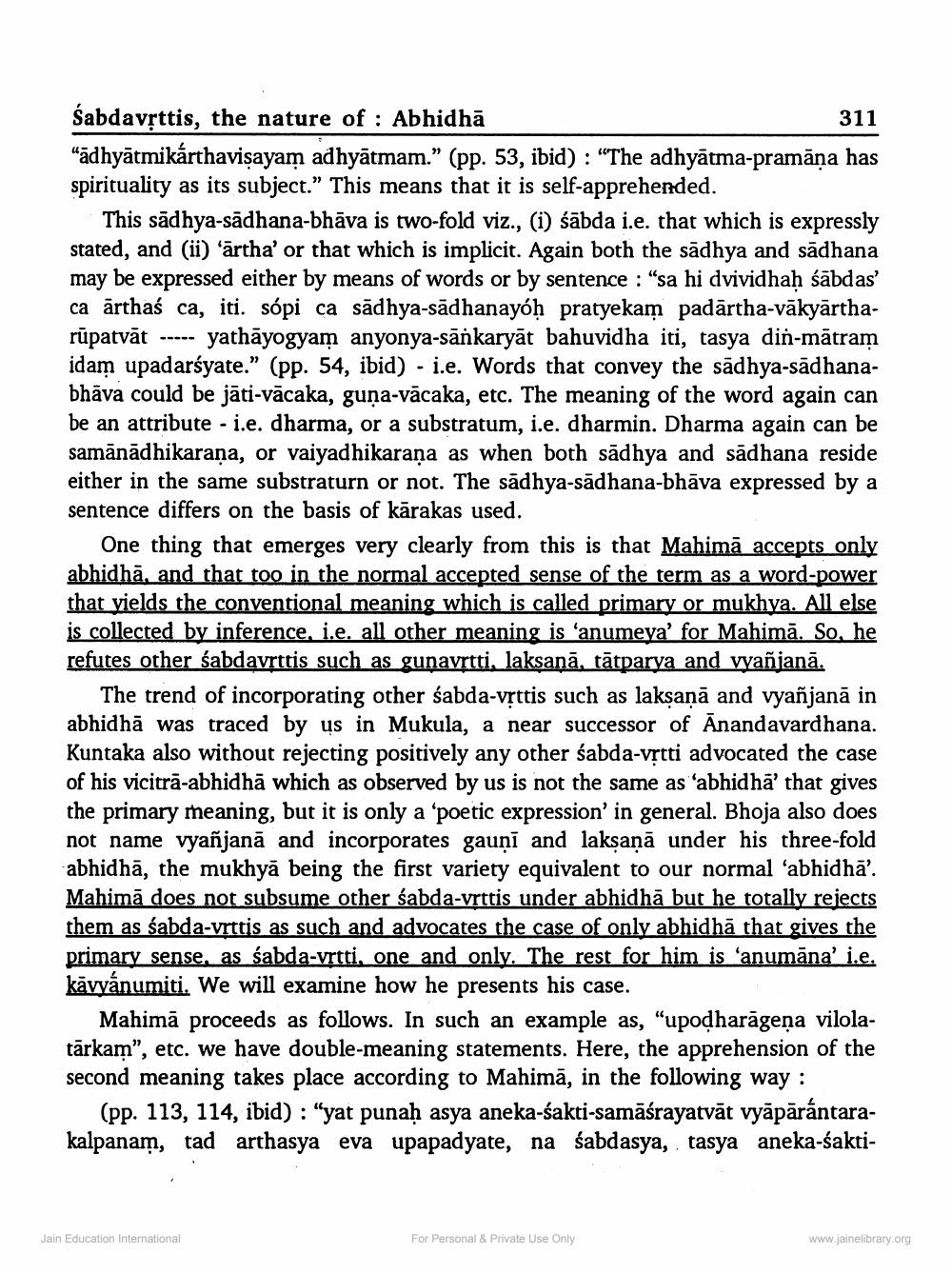________________
Sabdavṛttis, the nature of : Abhidhā
311
"adhyātmikárthaviṣayam adhyātmam." (pp. 53, ibid) : "The adhyātma-pramāṇa has spirituality as its subject." This means that it is self-apprehended.
This sadhya-sādhana-bhāva is two-fold viz., (i) śābda i.e. that which is expressly stated, and (ii) 'ārtha' or that which is implicit. Again both the sadhya and sadhana may be expressed either by means of words or by sentence: "sa hi dvividhaḥ śabdas' ca arthaś ca, iti. sópi ca sadhya-sadhanayóḥ pratyekam padartha-vākyārtharūpatvāt yathayogyam anyonya-sankaryāt bahuvidha iti, tasya din-matram idam upadarśyate." (pp. 54, ibid) - i.e. Words that convey the sadhya-sādhanabhāva could be jāti-vācaka, guṇa-vācaka, etc. The meaning of the word again can be an attribute - i.e. dharma, or a substratum, i.e. dharmin. Dharma again can be samānādhikaraṇa, or vaiyadhikaraṇa as when both sadhya and sadhana reside either in the same substraturn or not. The sadhya-sadhana-bhāva expressed by a sentence differs on the basis of kārakas used.
➖➖➖➖➖
One thing that emerges very clearly from this is that Mahimā accepts only abhidhā, and that too in the normal accepted sense of the term as a word-power that yields the conventional meaning which is called primary or mukhya. All else is collected by inference, i.e. all other meaning is 'anumeya' for Mahimā. So, he refutes other sabdavrttis such as gunavṛtti, laksanā, tātparya and vyañjanā.
The trend of incorporating other sabda-vṛttis such as lakṣaṇā and vyañjanā in abhidha was traced by us in Mukula, a near successor of Anandavardhana. Kuntaka also without rejecting positively any other sabda-vṛtti advocated the case of his vicitra-abhidha which as observed by us is not the same as 'abhidha' that gives the primary meaning, but it is only a 'poetic expression' in general. Bhoja also does not name vyañjana and incorporates gauni and lakṣaṇā under his three-fold abhidhā, the mukhyā being the first variety equivalent to our normal 'abhidha'. Mahima does not subsume other śabda-vrttis under abhidhā but he totally rejects them as śabda-vṛttis as such and advocates the case of only abhidha that gives the primary sense, as śabda-vṛtti, one and only. The rest for him is ‘anumāna' i.e. kävyánumiti. We will examine how he presents his case.
Mahimā proceeds as follows. In such an example as, "upoḍharāgena vilolatārkam", etc. we have double-meaning statements. Here, the apprehension of the second meaning takes place according to Mahimā, in the following way :
(pp. 113, 114, ibid): "yat punaḥ asya aneka-śakti-samāśrayatvāt vyāpārántarakalpanam, tad arthasya eva upapadyate, na śabdasya, tasya aneka-śakti
Jain Education International
For Personal & Private Use Only
www.jainelibrary.org




